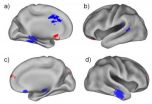(Press-News.org) Modesto, CA (Dec. 16, 2010) – With nearly 16 million Americans living today with prediabetes, a condition that is the precursor to type 2 diabetes, and half of all Americans expected to have either prediabetes or type 2 diabetes by the year 2020, nutritional approaches to maintaining healthy blood sugar levels are essential.1,2 The findings of a scientific study examining the health promotion and disease prevention benefits of almond consumption were published in the June, 2010 Journal of the American College of Nutrition. The study, one of the first of its kind to quantify prevention data, illustrates that consuming an almond-enriched diet may help improve insulin sensitivity and decrease LDL-cholesterol levels in those with prediabetes.3,4
The study looked at the effects of consuming an almond-enriched diet on factors linked to the progression of type 2 diabetes and cardiovascular disease in adults with prediabetes. After 16 weeks of consuming either an almond-enriched or regular diet, both in accordance with American Diabetes Association (ADA) recommendations, the group that consumed an almond-enriched diet showed significantly improved LDL-cholesterol levels and measures of insulin sensitivity, risk factors for heart disease and type 2 diabetes. A caveat is that although study participants in both groups were instructed to consume the same amount of calories from carbohydrates, there was less self-reported carbohydrate intake among those in the almond group.4
"We have made great strides in chronic disease research from evidence of effective treatment to evidence of effective prevention" said Dr. Michelle Wien, Assistant Research Professor in Nutrition at Loma Linda University's School of Public Health and Principal Investigator for this study, which was conducted at the University of Medicine and Dentistry of New Jersey. Wien adds, "It is promising for those with risk factors for chronic diseases, such as type 2 diabetes and cardiovascular disease, that dietary changes may help to improve factors that play a potential role in the disease development. It would be beneficial to conduct tightly controlled metabolic feeding studies and postprandial studies that feature controlled amounts of carbohydrate to confirm the findings of this study, which was performed in a free-living population."
Study at a Glance:
The People: 65 adults with prediabetes (48 women and 17 men) with an average age of 53.5 +10y.4
The Diet: The study population was randomly divided into either the intervention or control group. The control group consumed a diet that conformed with the American Diabetes Association (ADA) recommendations, which consists of 15-20% calories from protein, 10% total energy from saturated fat, 60-70% from carbohydrate and monounsaturated fatty acids (MUFA) and cholesterol < 300mg/day for 16 weeks, excluding all nuts. The intervention group consumed the ADA-recommended diet with 20% of the calories from almonds.4
The Results: The intervention group, who were on an almond-enriched diet, showed greater improvements in insulin levels (-1.7µU/ml vs. +1.47µU/ml, p=0.002), homeostasis model analysis for insulin resistance (-0.48 vs. +0.30, p=0.007), homeostasis model analysis for beta-cell function (-13.2 vs. +22.3, p=0.001) and clinically significant reductions in LDL-cholesterol (-12.4 mg/dl vs. -0.4 mg/dl) as compared to the nut-free group.4
This study suggests that consuming an ADA-recommended diet consisting of 20% of the total calories from almonds for 16 weeks is effective in improving LDL cholesterol levels and measures of insulin sensitivity in individuals with prediabetes.4 Nutrients in almonds, such as fiber and unsaturated fat, have been shown to help reduce LDL-cholesterol levels, increase insulin sensitivity and increase beta-cell function, all of which can help to prevent the development of type 2 diabetes and reduce the risk of cardiovascular disease.
This study contributes to the growing body of evidence that suggests that almonds contribute to heart health. However, this study adds a new dimension to the existing research as it shows that almond consumption not only aids in disease management, but may contribute to risk reduction for certain chronic diseases through their nutrient composition. Almonds offer 3.5 grams of fiber, 13 grams of unsaturated fat and only 1 gram of saturated fat per one-ounce serving.5
INFORMATION:
Consumers all over the world enjoy California Almonds as a natural, wholesome and quality food product, making almonds California's leading agricultural export in terms of value. The Almond Board of California promotes almonds through its research-based approach to all aspects of marketing, farming and production on behalf of the more than 6,000 California Almond growers and processors, many of whom are multi-generational family operations. Established in 1950 and based in Modesto, California, the Almond Board of California is a non-profit organization that administers a grower-enacted Federal Marketing Order under the supervision of the United States Department of Agriculture. For more information on the Almond Board of California or almonds, visit www.AlmondBoard.com.
1 Cowie CC, et al. Full accounting of diabetes and pre-diabetes in the U.S. population in 1988-1994 and 2005-2006. Diabetes Care 32 : 287-294, 2009.
2 United Health Center for Health Reform and Modernization. The United States of Diabetes : Challeneges and Opportunities in the Decade Ahead. November 2010. http://www.unitedhealthgroup.com/hrm/UNH_WorkingPaper5.pdf
3 Scientific evidence suggests, but does not prove, that eating 1.5 ounces per day of most nuts, such as almonds, as part of a diet low in saturated fat and cholesterol may reduce the risk of heart disease.
4 Wien M, et al. Almond consumption and cardiovascular risk factors in adults with prediabetes. J Am Coll Nutr. 2010 Jun;29(3):189-97.
5 U.S. Department of Agriculture, Agricultural Research Service, 2010. USDA National Nutrient Database for Standard Reference, Release 23. Nutrient Data Laboratory Page, http://www.ars.usda.gov/ba/bhnrc/ndl
When children are exposed to head and neck radiation, whether due to cancer treatment or multiple diagnostic CT scans, the result is an increased risk of thyroid cancer for the next 58 years or longer, according to University of Rochester Medical Center research.
The study is believed to be the longest of any group of children exposed to medical irradiation and followed for thyroid cancer incidence. It was published in the December 2010 edition of the journal, Radiation Research.
The data also might provide some insight about why the rates of thyroid cancer continue ...
AMES, Iowa – Wind turbines in Midwestern farm fields may be doing more than churning out electricity. The giant turbine blades that generate renewable energy might also help corn and soybean crops stay cooler and dryer, help them fend off fungal infestations and improve their ability to extract growth-enhancing carbon dioxide [CO2] from the air and soil.
Speaking at the annual meeting of the American Geophysical Union, a scientific society, in San Francisco today, a researcher at the U.S. Department of Energy's Ames Laboratory and his co-researcher from the University ...
Challenging students take up more of their teachers' time—and the difference between a tougher student and an easier one appears to be genetic, according to a new study published in Psychological Science, a journal of the Association for Psychological Science. The study looked at young twins in the U.K. and asked their teachers how much of a handful they are.
"Policy-wise, there's a lot going on, blaming teachers for what's going on in the classrooms," says Renate Houts of Duke University, who cowrote the study with Avshalom Caspi and Terrie E. Moffitt of Duke, Robert ...
AUDIO:
People with a known risk for Alzheimer’s disease seem to develop abnormal brain function even before the appearance of amyloid plaques in the brain. A new study from Washington University...
Click here for more information.
People with a known, high risk for Alzheimer's disease develop abnormal brain function even before the appearance of telltale amyloid plaques that are characteristic of the disease, according to a new study.
Researchers at Washington University ...
Results of a five-year monitoring effort to repair seagrass damaged in a boat grounding incident suggest that restoration techniques such as replanting seagrass can speed recovery time. The finding is included in a new report released today by NOAA's Office of National Marine Sanctuaries.
The National Marine Sanctuaries Conservation Series report, "N-Control Seagrass Restoration Monitoring Report Monitoring Events 2003-2008," presents results of efforts to repair a nearly 1,000-square-foot (92.8-square-meter) swath of seagrass that was damaged on May 29, 2001, when a ...
To answer the big questions, it often helps to look at the smallest details. That is the approach Stanford mineral physicist Wendy Mao is taking to understanding a major event in Earth's inner history. Using a new technique to scrutinize how minute amounts of iron and silicate minerals interact at ultra-high pressures and temperatures, she is gaining insight into the biggest transformation Earth has ever undergone – the separation of its rocky mantle from its iron-rich core approximately 4.5 billion years ago.
The technique, called high-pressure nanoscale X-ray computed ...
A mathematically driven evolutionary snapshot of woody plants in four similar climates around the world has given scientists a fresh perspective on genetic diversity and threats posed by both extinctions and loss of habitat.
The message from the study, appearing online ahead of publication in Ecology Letters, says lead author Hélène Morlon, is that evolutionary diversity -- the millions of years of evolutionary innovations contained in present-day species -- is more sensitive to extinctions or loss of habitat than long thought. And that, she adds, means conservation efforts ...
Older people have a hard time keeping a lid on their feelings, especially when viewing heartbreaking or disgusting scenes in movies and reality shows, psychologists have found. But they're better than their younger counterparts at seeing the positive side of a stressful situation and empathizing with the less fortunate, according to research from the University of California, Berkeley.
A team of researchers led by UC Berkeley psychologist Robert Levenson is tracking how our emotional strategies and responses change as we age. Their findings – published over the past ...
A University of California, Berkeley, geophysicist has made the first-ever measurement of the strength of the magnetic field inside Earth's core, 1,800 miles underground.
The magnetic field strength is 25 Gauss, or 50 times stronger than the magnetic field at the surface that makes compass needles align north-south. Though this number is in the middle of the range geophysicists predict, it puts constraints on the identity of the heat sources in the core that keep the internal dynamo running to maintain this magnetic field.
"This is the first really good number we've ...
The PSA screening test for prostate cancer is not perfect. It can indicate cancer when none is present and miss life-threatening tumors. But a new study suggests the test is more reliable in men taking dutasteride (Avodart®), a drug widely prescribed to shrink an enlarged prostate gland.
Dutasteride lowers PSA levels by about half within six months. But the researchers found that even a slight rise in PSA levels among men taking the drug was a stronger indicator of prostate cancer, particularly aggressive tumors that require early diagnosis and treatment, than rising ...

